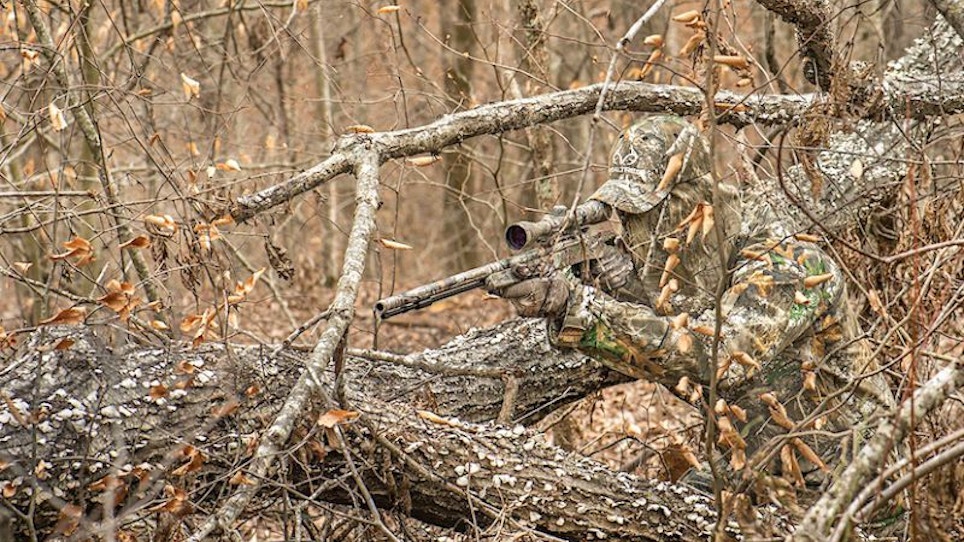Camouflage is big business.
Consider how many companies have their own camouflage patterns. Add to that all the companies licensed to use those patterns on their clothing, and you end up with a big segment of the hunting attire industry.
Indeed, camouflage clothing is a growing industry among both hunters and camo enthusiasts who see such clothing as more of a fashion statement. Gone are the days when traditional market leaders like Mossy Oak and Realtree were considered the only companies for hunters to consider. A handful of newer camouflage companies have entered the market, along with some other companies that have done well over the years and continue to thrive.
Of course, Mossy Oak and Realtree are both fine companies that produce great camo and continue to innovate new and better patterns. And they have successfully used their camouflage to catapult themselves into very successful all-around hunting brands.
But the fact remains that some of the newcomers are getting a lot of attention these days. One such company is Veil Camouflage.
The Veil Story
Joseph Skinner is the founder of Veil Camouflage. He’s also the pattern designer. But he wasn’t a design student, rather a musician who went to West Point.
“I didn’t grow up hunting, fishing or really doing anything outside for the most part,” Skinner says. “But in the military, I couldn’t figure out why they had chosen to deploy that camouflage pattern throughout the entire Army. I knew it was a terrible pattern, but I didn’t really understand why.”
Fast forward to about 2010 when Skinner decided to take up hunting. To him, all of the camo patterns available were either trying too hard to match a very specific location or didn’t seem to live up to their promises. Disgruntled, he took up camo design as a hobby.
“I devoured everything I could possibly get my hands on to start learning what it was that my gut was telling me,” Skinner said. “I was sitting in a treestand one day looking across the field to the timber on the other side and I noticed, really for the first time — hey, nature grows in fractals (self-repeating patterns). But it’s not perfect.”
Combining fractal math with chaos theory, Skinner designed his first pattern, which he sold to First Light in 2012. The rest, as they say, is history. Veil was created shortly thereafter and now has more than 32 camo patterns, including proprietary patterns for many large retailers.
Now, Skinner’s entire job is to keep pushing camouflage technology and making it better. Thanks to his years in the industry, he has some valuable insights for retailers.
“We’re involved with some of the biggest retailers out there,” he says. “With the exception of Bass Pro, Cabela’s and Dick’s Sporting Goods, we pretty much have at least one proprietary pattern with everybody else. Very early on in Veil, we realized that the consumer is ready for a shift. That’s what we’re seeing now.”
Skinner says retailers are seeing a huge change in where people want to put their money. Hunters don’t want the same old thing. Instead, they want whatever is going to give them an edge in more critical situations.
“As we see this shift, retailers have to be aware of that and be nimble enough to pivot their strategy to match what the consumer demand is going to be,” Skinner says. “If retailers want to move product, they have to take that into consideration.”
It’s important that retailers consider style of garments in addition to camouflage patterns when selecting camo clothing that will suit their hunting and outdoor apparel customers’ wants and needs.
“We’ve seen over the last handful of years a big shift toward layering systems, which is great,” Skinner says. “From a retail perspective, you’re able to offer the consumer something that is really tip-to-tail camo’d out. You’re offering a more comprehensive solution rather than just a jacket, pants and a ‘Good luck, bud.’ And that has elevated the consumer experience.
“The challenge is making sure you can bring that versatility and that number of SKUs to the consumer in a way that doesn’t bankrupt them.”
For retailers, Skinner believes that camouflage clothing can be a high-margin category that makes good profit, although it can also yield very little profit if poor decisions are made.
“In terms of profit margin, it’s the same as anything else,” he says. “It has to be a brand that people want. I would say the new styles are going to attract more eyes and get people more excited about that type of product. That’s what we’ve seen with all of our partners.”
Tailoring camouflage to the local market is also an important consideration. Skinner has extensive experience in that category.
“Take Sportsmen’s warehouse, for instance,” he says. “We have two patterns with them from their in-house brand. When we set out to develop a pattern for them, we worked with them to understand what their local market was — what they are using it for.
“It has to make sense for your consumer. So, if your consumer is out West, you’re not going to do something that is East-oriented.”
Inventory is another critical consideration for retailers, and there are no easy answers since knowing your customers is generally the most important factor.
“Inventory is always the challenge, right? You don’t want to hold on to too much, and you want to make sure that it moves,” he says. “If you offer something that’s really attractive and fairly priced, it’s going to move. Obviously, marketing has to come into play. But if a retailer has buy-in for a camo brand or a pattern on their own garments, if it makes sense, it’s going to move. If it doesn’t make sense, it’s going to stay put.”
Skinner acknowledges that the direct-to-consumer shift has taken a huge bite out of the retail industry, especially in terms of camo apparel. Consequently, retailers have to make sure they are giving their consumers what they want in order to keep them in their store.
“It’s really up to the retailer to decide how they want to succeed,” Skinner said. “Despite my bias, the path is fairly clear based on what’s happening and has been happening in the industry now for the better part of the decade. Retailers have to decide, do they dig their heels in? Or do they try new things? Because that’s what more and more people are becoming interested in.”
For retailers, the number of camo companies and patterns, along with all the licensing agreements and other associated business details, can be perplexing. Here’s a brief look at some top camo companies, their patterns and where and when those patterns work best.
Brands and Patterns
Bill Jordan created Realtree in 1986. Since then, Jordan has never stopped innovating, and his current patterns are some of the most popular in the world.
Realtree Edge is one of the company’s bestsellers. The pattern features an abstract, three-dimensional background, realistic natural elements and colors, and highlights and shadows to break up the outline. The company’s newer Excape pattern is purposefully designed to appear unstructured while distinctly mimicking natural elements. Built specifically for big-game hunters, the company says it enables them to escape visual detection by easily blending into surroundings.
The company’s Max-5 pattern, filled with cattails, reeds, cane and grasses, was designed with waterfowl hunters in mind. Also designed for duck hunters, Realtree’s Timber pattern is touted as one of the most effective and lifelike patterns for waterfowlers hunting in flooded timber.
Mossy Oak has created a similar success story. In 1986, company founder and CEO Toxey Haas had the vision to take a handful of Mississippi dirt, sticks and leaves and transform it into a brand-new type of camouflage. Mossy Oak Bottomland was born, and so was a company that is now an outdoor legend.
Even decades later, Bottomland continues to be the choice of many hunters who have trusted it for years. Improvements to the original design include digitally enhanced natural bark elements for ultimate effectiveness. Mossy Oak Break-Up Country is an all-purpose camo that features a variety of elements found throughout North America, with true-to-size elements and good depth and shadowing.
The company’s Obsession pattern is lethal in the spring turkey woods, and Shadow Grass Blades is a popular waterfowl pattern featuring a precise arrangement of individual blades of grass onto a background of thatch.
Sitka has been producing quality camouflage since 2009. With the help of a military camouflage designer and an animal vision expert, the company has developed some outstanding patterns over the years.
The company’s Elevated II pattern is designed for whitetail hunters. Its macro- and micro-pattern configurations echo the higher contrast of bright sky against the shaded underside of foliage. Designed for backcountry hunters, Sitka’s Open Country pattern uses the larger neutral areas of the pattern more critical to concealment at greater engagement ranges.
For waterfowlers, Sitka offers two patterns: Waterfowl Marsh and Waterfowl Timber. Both were scientifically engineered based on how waterfowl see.
Founded in 2011 by a group of tactical gear experts and entrepreneurs passionate about hunting and the outdoors, Onca Gear’s high-end camo collection is the result of 20-plus years of research and expertise.
“We developed multiple designs in different patterns and tested them all in the field to assess the effectiveness in different environments and how the animals reacted,” the company states.
The result is Onca’s one-camo-fits-all Camo Ibex pattern that adapts to nearly any hunting environment.
As mentioned earlier, Veil Camo has also become a player in the industry and deserves attention from retailers. Veil has 11 hunting patterns, including Flagship, which is designed to be the gold standard for all-terrain, multiseason concealment. K2 is designed specifically for hunting a number of species in the mountains of the western United States.
Along with 11 fishing camo patterns and six tactical patterns, Veil also offers three waterfowl patterns: Emergent, Avayde and West River Verdant.
Last but not least, Predator camouflage was started back in 1988 and is recognized as the original creator of open pattern technology for camo. Brown Deception was introduced in 2001 and utilizes nine different brown earth tones to allow hunters to “disappear.” Introduced a few years later, Green Deception gives hunters an early-season color advantage that allows them to blend seamlessly into green surroundings.
Another popular Predator pattern, 3-D Deception, features state-of-the-art digital printing technology in a palette of subtle colors to dissolve in almost any terrain.
Yes, camouflage can be a complicated part of the shooting sports retail business. But with the high demand and growing number of patterns, it can be a great profit center if you tailor your offerings properly for your local market.







